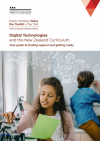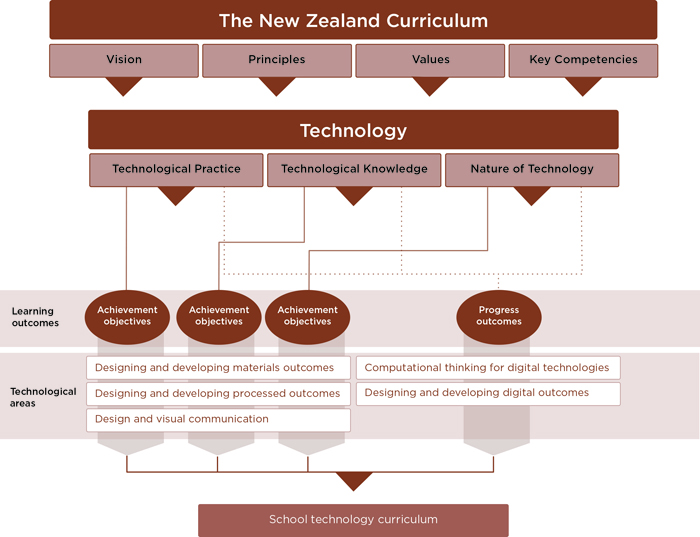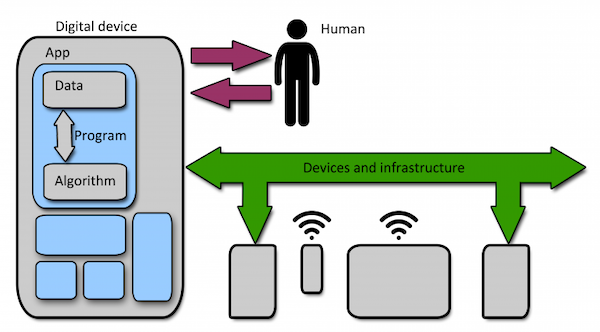Digital technologies and the technology learning area
Learning about and with digital technologies will contribute to developing an informed digital society.
The Technology learning area has been revised to strengthen the positioning of digital technologies in The New Zealand Curriculum and Te Marautanga o Aotearoa. This is for all students from year 1–13. Students have the opportunity to specialise from year 11–13.
The goal of this change is to ensure that all learners have the opportunity to become digitally capable individuals.
The change provides a greater focus on students building their skills so they can be innovative creators of digital solutions, moving beyond solely being users and consumers of digital technologies.
“The digital curriculum is about teaching children how to design their own digital solutions and become creators of, not just users of, digital technologies, to prepare them for the modern workforce."
In this video from the Education Gazette, students, teachers, leaders, and employers explore why it is so important for students to be given the opportunity to become creators of digital technologies in our society.
The New Zealand Curriculum
In the Technology Learning area there are two new technological areas:
Computational thinking for digital technologies – Students will develop an understanding of computer science principles that underlie all digital technologies. They’ll learn core programming concepts so that they can become creators of digital technology, not just users.
Designing and developing digital outcomes – Students will learn how to design quality, fit-for-purpose digital solutions.
Te Marautanga o Aotearoa
In the Hangarau Wāhanga Ako, there are two new tupuranga.
- Te Whakaaro Rorohiko (Computational thinking) – Includes using te reo Māori to express problems, formulate solutions and solve them using algorithms, programme and data representation.
- Tangata me te Rorohiko (People and computers) – Includes designing and developing digital outcomes while considering their role and responsibility as digital citizens.
Hangarau Matihiko – Information brochure to support kura and kaiako to implement the Hangarau Matihiko curriculum content.
Kauwhata Reo – contains videos and exemplars to support introducing and teaching these strands.
The new content has been designed to be flexible, so it can respond to new developments and technologies as they emerge.
More information »
- Digital technologies questions and answers – Technology Online answers the most common questions educators have been asking about digital technologies within the revised technology learning area.
- Digital Technologies and Hangarau Matihiko learning – Ministry of Education information for schools and kura, students, parents and whānau, businesses and employers.
Support for schools
Digital technologies implementation support tool 2020
This tool gives a model process and plan to support schools with teaching the revised Technology Learning Area. It is for school leaders, school teams, clusters of schools, and boards of trustees to help with change planning.
Leading local curriculum design in the revised technology learning area (PDF, 3 MB)
This guide is for technology curriculum leaders in primary and secondary schools. The guide outlines why learning in technology is so important for students and summarises what has changed in the learning area. It describes four high-impact practices to help you design and implement a school curriculum that will enable all your students to become confident technology learners.
Digital technologies professional supports
Information about professional supports and initiatives for digital technologies.
This downloadable resource helps you and your community learn more about:
- the new digital technologies content within the curriculum
- how you can access support to help unpack the new content.
Support for teachers
Raranga Matihiko | Weaving Digital Futures
Raranga Matihiko are museum-led workshops that weave student and ākonga learning through digital technologies, creative exploration, and collaboration.
Inspired by museum taonga, primary and secondary school students, and kura ākonga will share their stories through a range of digital products.
Te Papa is working in partnership with Auckland Museum Tāmaki Paenga Hira, Waitangi Treaty Grounds and Te Kōngahu Museum of Waitangi, and MTG Hawke’s Bay to deliver Raranga Matihiko to students across Aotearoa New Zealand.
This programme is provided at no cost to the school. The costs covered include Teacher Release Day (TRD) for one planning day, transport while visiting the museum, facilitation, and technology use.
Tahi Rua Toru Tech is a national team-based challenge about creating solutions for real-world problems using digital technologies.
Support from Enabling e-Learning
Visit these Enabling e-Learning pages for further information, stories, resources and research around particular aspects of Designing and Developing Digital Outcomes and Computational Thinking for Digital Technologies:
Understanding computational thinking
Computational thinking is about looking at a problem in a way that a computer can help us to solve it.
It is not thinking about computers or like computers.
Computational thinking for digital technologies – technological area
Computational thinking enables students to express problems and formulate solutions in ways that means a computer (an information processing agent) can be used to solve them.
In this area, students develop algorithmic thinking skills and an understanding of the computer science principles that underpin all digital technologies. They become aware of what is and isn’t possible with computing, allowing them to make judgments and informed decisions as citizens of the digital world.
Students learn core programming concepts and how to take advantage of the capabilities of computers, so that they can become creators of digital technologies, not just users. They develop an understanding of:
- how computer data is stored
- how all the information within a computer system is presented using digits
- the impact that different data representations have on the nature and use of this information.
The thinking undertaken before starting work on a computer is computational thinking.
Computational thinking is a two-step process:
- Identify the steps needed to solve a problem.
- Use your technical skills to get the computer "working" on the problem.
For example, if you’re going to make a video animation, you need to:
- start by planning the storyboard
- then, use computer hardware and software to help you get the work done.
Computational thinking is a problem solving process that includes a number of characteristics and dispositions.
- It is essential to the development of computer applications.
- It can be used to support problem solving across the curriculum.
Operational definition of computational thinking for K-12 education
Computational thinking is a problem-solving process that includes (but is not limited to) the following characteristics:
- formulating problems in a way that enables us to use a computer and other tools to help solve them
- logically organising and analysing data
- representing data through abstractions such as models and simulations
- automating solutions through algorithmic thinking (a series of ordered steps)
- identifying, analysing, and implementing possible solutions with the goal of achieving the most efficient and effective combination of steps and resources
- generalising and transferring this problem-solving process to a wide variety of problems.
These skills are supported and enhanced by a number of dispositions or attitudes that are essential dimensions of CT. These dispositions or attitudes include:
- confidence in dealing with complexity
- persistence in working with difficult problems
- tolerance for ambiguity
- the ability to deal with open-ended problems
- the ability to communicate and work with others to achieve a common goal or solution.
More information »
- Computational thinking for educators – A resource for teachers, with a free online course to help teachers integrate computational thinking into their classroom curriculum.
- Computational thinking with Scratch – Defining, assessing, and supporting computational thinking.
- Computational thinking – A clear explanation of computational thinking which expands on the concepts and approaches. Registration for this site is free, and provides access to useful classroom resources.
- Computational thinking: Progress outcomes, exemplars, and snapshots
- Kia Takatū ā-Matihiko: Kidbots flyer – This resource is a starting point for how you can teach programming through a non-computerised task.
Understanding designing and developing digital outcomes
Designing and developing digital outcomes – technological area
In this area, students understand that digital applications and systems are created for humans by humans. They develop increasingly sophisticated understandings and skills for designing and producing quality, fit-for-purpose, digital outcomes. They develop their understanding of the technologies people need in order to locate, analyse, evaluate and present digital information efficiently, effectively and ethically.
Students become more expert in manipulating and combining data, using information management tools to create an outcome. They become aware of the unique intellectual property issues that arise in digital systems, particularly with approaches to copyright and patents. They also develop understandings of how to build, install, and maintain computers, networks and systems so that they are secure and efficient.
Students develop knowledge and skills in using different technologies to create digital content for the web, interactive digital platforms and print. They construct digital media outcomes that integrate media types and incorporate original content. They also learn how electronic components and techniques are used to design digital devices and integrated to assemble and test an electronic environment.
The progress outcomes
The progress outcomes describe the significant learning steps that students take as they develop their expertise in designing and developing digital outcomes.
- Progress outcomes 1–3, when aligned between levels 1–5 of the New Zealand Curriculum reflect the different learning and time required for each outcome.
- Progress outcomes 4–6 set out the learning expected for students engaging in more intensive and specialised digital technologies programmes for NCEA 1, 2, and 3. They are directly aligned with levels 6–8 of the curriculum.
In this video, Joanne Roberts and Melissa Jones share examples of conversation prompts to use with students. See also the following Kia Takatū ā-Matihiko resources:
- Conversation starters for learning in Designing and Developing Digital Outcomes
- Designing and Developing Digital Outcomes
More information »
Digital Technologies as part of the Technology learning area in the New Zealand Curriculum
Digital Technologies is learning about technology. It involves learning to be a creator in the digital world, not just learning to use systems.
The Technology learning area has the three strands: technological practice, technological knowledge, and nature of technology. Below this are five technological areas:
- Designing and developing materials outcomes
- Designing and developing processed outcomes
- Design and visual communication
- Computational thinking for digital technologies
- Designing and developing digital outcomes
The three strands provide the organising structure for the five technological areas:
- achievement objectives – Designing and developing materials outcomes, Designing and developing processed outcomes, Design and visual communication
- progress outcomes – Computational thinking for digital technologies, Designing and developing digital outcomes.
- Digital Technologies – Achievement objectives, indicators, and teacher guidance for Levels 6-8 from Technology Online.
Key resources
- NZ Curriculum online | Technology – The technology learning area structure, achievement objectives, and progress outcomes.
- Digital technologies curriculum support – Technology online provides information, exemplars, and snapshots of learning.
Cross-curricular opportunities for integrating digital technologies
"Learning in digital technologies links to learning across all learning areas and wāhanga ako."
The technological areas provide contexts for learning. At primary school, teachers will generally take a cross-curricular approach, with students learning in the technological areas as part of a topic or theme that encompasses several curriculum learning areas. This approach can also be applied in years 9 and 10, before students begin to specialise in particular technological areas.
This video demonstrates an approach to integrating digital technologies across the curriculum. This is a demonstration of an activity from the Computer Science Unplugged collection of games and activities. It demonstrates Computer Science without using computers. For more information, see the activity called "Treasure Hunt – Finite-State Automata" at http://csunplugged.org .
In this video, Julie McMahon from St. Hilda's Collegiate School explains how year nine and ten students have made cross-curricular connections.
More information »
- Computational thinking for school students and teachers – what's the big idea? – A talk given by Tim Bell (University of Canterbury) as part of an international on-line conference in 2016. It includes demonstrations with students.
- Computer science unplugged – A collection of free teaching material that teaches Computer Science through engaging games and puzzles that use cards, string, crayons, and lots of running around. The resources available to teachers include unit plans, lesson plans, teaching videos, curriculum integration activities, and programming exercises to plug in the Computer Science concepts they have just learnt unplugged.
Digital Technologies and e-learning
The Digital Technologies technological areas involve students learning how to create digital solutions through the use of information systems and specific ways of thinking about problem solving. Through the application of the logical reasoning (computational thinking) students learn how to tackle problems by breaking them down into appropriate chunks and then creating a set of steps and decisions (algorithmics) that can be carried out using a digital device to create a solution. Its emphasis is more on developing students’ ability to think computationally, rather than on the use of a range of digital devices to produce information.
e-Learning primarily involves students using digital technologies to effectively communicate, collaborate, and create resources. The development and application of these capabilities involves the use of digital technologies or ICTs. This contrasts starkly with the Digital Technologies curriculum where much learning occurs unplugged, however, students will still apply their ICT capabilities to help their learning in Digital Technologies.
Understanding the relationship between digital fluency and digital technologies
Digital fluency is about using a digital system effectively. It means understanding how to use digital technologies, deciding when to use specific digital technologies to achieve a desired outcome, and being able to explain why the technologies selected will provide their desired outcome.
Digital technologies involves computational thinking – learning to be a creator in the digital world, not just learning to use systems. Digital Technologies is not about learning with technology (e-learning), it's learning about technology.
Both are important, but if we teach students only to use digital devices, they will be consumers limited to making do with whatever the makers of digital technologies produce, and as a country we will be buying in technology rather than creating it and selling it to others.
Tim Bell (University of Canterbury)
More information »
- Digital fluency – Information and school stories to support teachers plan for building digital fluency.
Understanding the structure of digital technologies
For students to have the basis for understanding future digital systems, they need to develop:
- an understanding of what a digital system is
- recognise the opportunities and limitations provided by a digital system.
- The first digital computers developed in the 1940s, and the latest smartwatches, are all based on this structure.
- Digital devices run applications (also referred to as programs, software, or apps).
- Applications work with data, which might be as simple as the number of steps taken on a fitness tracker, or as complex as every transaction in a large organisation.
- An algorithm is a process that acts on the data. For example, a fitness tracker stores data about number of steps taken, and one algorithm used is to add one to the number of steps whenever a step is detected; another algorithm might make decisions about how you are reaching your fitness goal.
- A program is the implementation of an algorithm to process data; there are many ways to program (code) an algorithm, but a computer needs a program to be able to carry out the intention of the algorithm.
- The main part of the system is the human, who gets information in and out of the system using an interface (which might involve buttons, images, sound, vibration, and more).
- Devices and infrastructure – devices are connected to each other through networks (which could be as simple as a USB connection, or as complex as the internet).
Enabling e-Learning supports
NZ Curriculum information
NZ Curriculum online | Technology
The technology learning area structure, achievement objectives, and progress outcomes.
Digital technologies curriculum support
Technology online provides information, exemplars, and snapshots of learning.
Digital technologies questions and answers
Technology Online answers the most common questions educators have been asking about digital technologies within the revised technology learning area.
Technology Online glossary of terms associated with the technology learning area.
Strengthening digital technologies | hangarau matihiko
A range of resources, case studies, and innovative ideas are now being developed for you to access and use.
Achievement objectives, indicators, and teacher guidance for Levels 6-8 on Technology Online.
Teaching resources
2018 Connected Series All have a focus on computational thinking for digital technologies and designing and developing digital outcomes.
- Connected 2018 Level 2 – Step by step
- Connected 2018 Level 3 – Cracking the code
- Connected 2018 Level 4 – Digital space
PLD to Integrate Computational Thinking into the Year 1–10 curriculum
This resource aims to equip you with the knowledge, practical skills, and tools to start your continuing learning journey in Computational Thinking. It also offers a range of extension opportunities for diverse learners.
Digital technologies – NZ Curriculum
This site contains resources to support the proposed Digital Technologies strand in the Technology Curriculum. This site has been developed by the Digital Fluencies team of the Institute of Professional Learning at the University of Waikato and Independent Facilitators to provide supporting resources for schools.
The Computer Science Field Guide (CSFG) is an online resource for teaching Computer Science to students. It is aimed directly at students. The project is open source and available on GitHub . If you are a teacher (or involved in education), you can join the CSFG teachers group to receive updates and access the teacher's version of the guide.
An English website, which supports primary educators with the confidence, knowledge, skills, and resources to teach computer science. It includes free lesson plans and activities, designed to help teachers gain confidence in bringing computer science to life in the classroom. Teachers from any country can register and access the resources.
CS Unplugged – Computer science without a computer
A collection of free learning activities that teach Computer Science through games and puzzles that use cards, string, crayons, and lots of running around. Suitable for all ages. The material is available free of charge, and is shared under a Creative Commons BY-NC-SA licence .
Computational thinking for all
ISTE's website provides and explanation of computational thinking and links to their Computational Thinking Toolkit.
Readings and information
Education Gazette Digital Technologies & Hangarau Matihiko Series (2020)
A series of five articles with accompanying video clips:
-
New curriculum content to equip students for future – provides the background to the new content and why is it important.
- Growing digital citizens of the future – West Rolleston Primary School has incorporated a digital thread throughout its curriculum and is taking teachers, the Board of Trustees, parents, and the wider community along on the journey.
- Curriculum of awe and wonder – Newlands Intermediate students are using its digital design and technology lab to develop and play games, collaborate on a photo editing project, and teach themselves how to create a 3D model for printing.
- Joining the dots – Innovative learning for a connected world: Rolleston College is building relationships to help learners develop innovative mindsets and find their places in a connected world.
- Now is the future – different ways schools and kura are working with communities, industry, and each other.
NZCER: Computational thinking in primary mathematics
Adding Digital Technologies curriculum content into primary classrooms may feel, to many primary teachers, like a new burden and more work—but many aspects of computational thinking can be explored in the context of our existing mathematics programmes. This article highlights the connection between computational thinking and mathematics, and presents examples of classroom activities that teach computational thinking and mathematics in ways that are meaningful and discourse-rich.
On your marks...Get set...Go! A tale of six schools and the digital technologies curriculum content
ERO conducted case studies of six schools’ implementation of the digital technologies curriculum content in Term 1, 2019. Schools that had successfully integrated the curriculum had leaders who promoted a growth mindset for teachers and looked to integrate digital technologies into existing curriculum. Timely professional development for teachers and positive community connections also enhanced schools’ ability to integrate the digital technologies curriculum.
NZTech advance education technology summit: Leading for 21st century learning
This NZTech briefing paper (published August 2016) provides insights from the NZTech Advance Education Technology Summit, including key observations from the Leaders Forum discussions about achieving digital fluency.
Computational thinking for school students and teachers – what's the big idea?
A talk given by Tim Bell (University of Canterbury) as part of an international on-line conference in 2016. It includes demonstrations with students.
Teacher support and discussions
Raranga Matihiko | Weaving Digital Futures
As part of the Ministry of Education Digital Technologies for All Equity fund, the Raranga Matihiko programme delivers innovative digital technologies to those with limited digital learning opportunities, while increasing access to national and local exhibitions and collections. This programme is provided at no cost to the school. The costs covered include Teacher Release Day (TRD) for one planning day, transport while visiting the museum, facilitation, and technology use.
Christchurch computer science for high schools event
Website for the annual free professional development week for high school teachers, held at the University of Canterbury in 2016. The event is a collection of workshops focused on preparing New Zealand educators for teaching the computer science and programming achievement standards for NCEA.
Christchurch computer science for primary schools workshops, at the University of Canterbury
Workshops are focused on preparing primary school teachers to integrate Computer Science into their classroom programmes.
Computational thinking for educators
A free online course for teachers to support understanding of computational thinking. It provides practical examples of how to integrate computational thinking into your classroom programme.
A website for New Zealand Digital Technology and Hangarau Matihiko educators.
Ministry of Education information
Digital Technologies and Hangarau Matihiko learning
Information about the curriculum and supports provided to schools and kura to assist with implementation.









